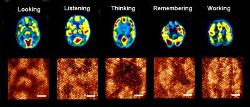Apr 26 2010
Information processing circuits in digital computers are static. In our brains, information processing circuits—neurons—evolve continuously to solve complex problems.
 Magnetic resonance images of human brain during different functions appear on top. Similar evolving patterns have been generated on the molecular monolayer one after another (bottom). A snapshot of the evolving pattern for a particular brain function is captured using Scanning Tunneling Microscope at 0.68 V tip bias (scale bar is 6 nm).
Magnetic resonance images of human brain during different functions appear on top. Similar evolving patterns have been generated on the molecular monolayer one after another (bottom). A snapshot of the evolving pattern for a particular brain function is captured using Scanning Tunneling Microscope at 0.68 V tip bias (scale bar is 6 nm).
Now, an international research team from Japan and Michigan Technological University has created a similar process of circuit evolution in an organic molecular layer that can solve complex problems. This is the first time a brain-like "evolutionary circuit" has been realized.
This computer is massively parallel: The world's fastest supercomputers can only process bits one at a time in each of their channels. Their circuit allows instantaneous changes of ~300 bits.
Their processor can produce solutions to problems for which algorithms on computers are unknown, like predictions of natural calamities and outbreaks of disease. To prove this unique feature, they have mimicked two natural phenomena in the molecular layer: heat diffusion and the evolution of cancer cells.
The monolayer has intelligence; it can solve many problems on the same grid.
Their molecular processor heals itself if there is a defect. This remarkable self-healing property comes from the self-organizing ability of the molecular monolayer. No existing man-made computer has this property, but our brain does: if a neuron dies, another neuron takes over its function.
The work is described in the Nature Physics paper "Massively parallel computing on an organic molecular layer." It is coauthored by Ranjit Pati, of the Michigan Technological University Department of Physics. Lead author is Anirban Bandyopadhyay, National Institute for Materials Science, National Institute of Information and Communication Technology, Japan.
Source: http://www.mtu.edu/